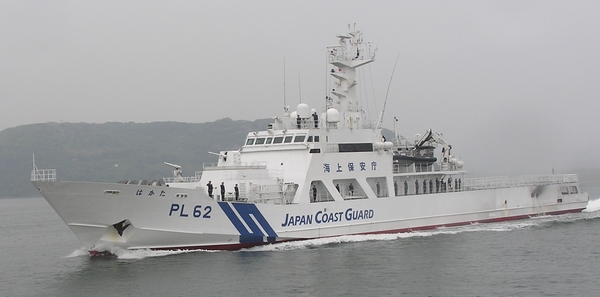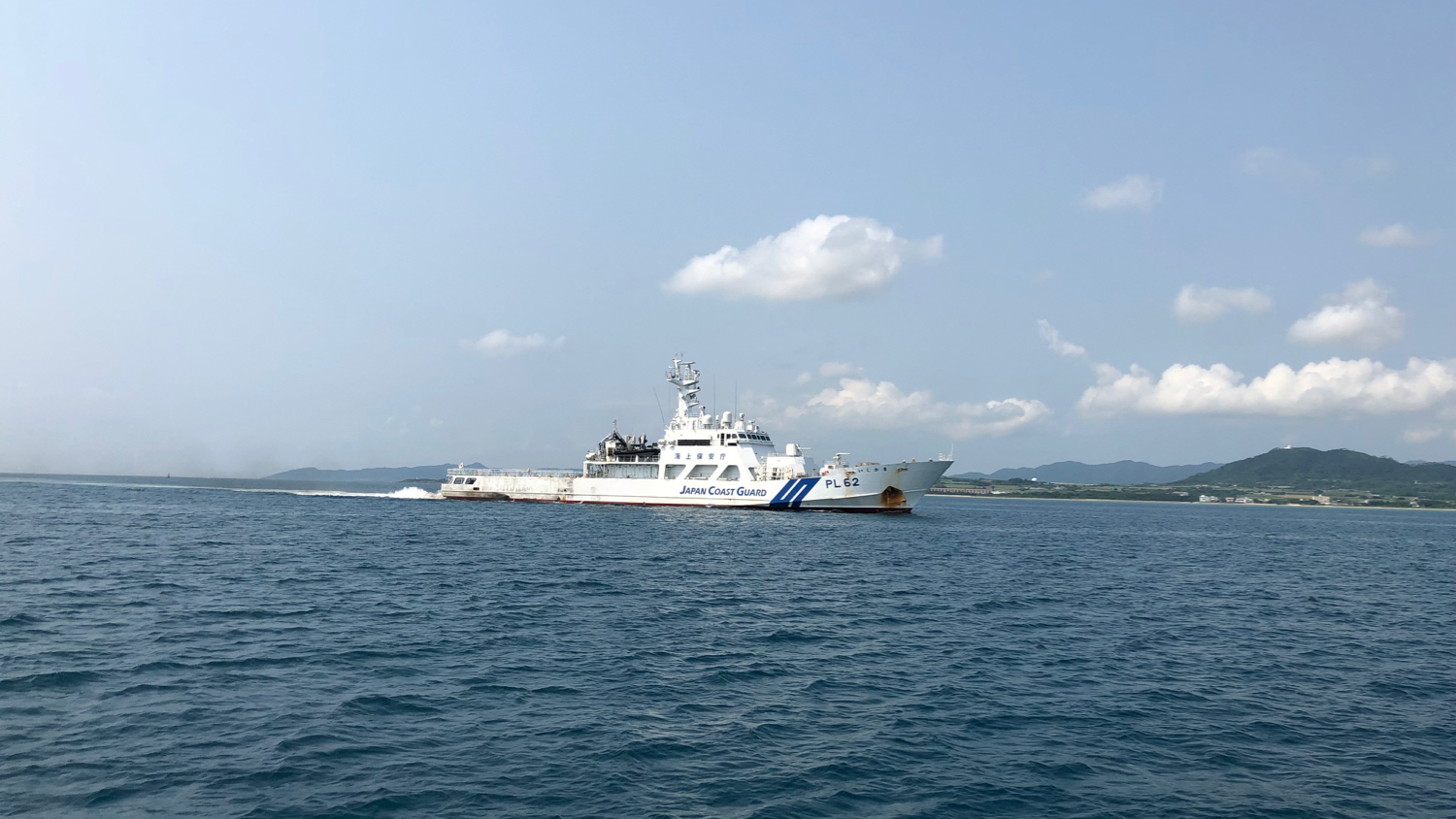Hateruma-class Patrol Vessel on:
[Wikipedia]
[Google]
[Amazon]
''Hateruma''-class patrol vessel ( ja, はてるま型巡視船) is a class of PL type


patrol vessels
A patrol boat (also referred to as a patrol craft, patrol ship, or patrol vessel) is a relatively small naval vessel generally designed for coastal defence, border security, or law enforcement. There are many designs for patrol boats, and they ...
of the Japan Coast Guard. PL stands for "Patrol vessel Large", and the class name "Hateruma" is named after Hateruma
Hateruma (波照間島; ''Hateruma-jima''; Yaeyama: ''Patirooma'', Hateruma dialect: ''Besїma'' "our island", Okinawan: ''Hatiruma'', Northern Ryukyuan: ''Patara'') is an island in the Yaeyama District of Okinawa Prefecture, Japan. It is the ...
-jima, the southernmost inhabited island of Japan.
Aiming at policing of Senkaku Islands
The are a group of uninhabited islands in the East China Sea, administered by Japan. They are located northeast of Taiwan, east of China, west of Okinawa Island, and north of the southwestern end of the Ryukyu Islands. They are known in main ...
, they can be a floating base for smaller patrol crafts or helicopters, so they are called "", ''Patrol vessel, Sea-basing capability enhanced''. The lead ship of the class, ''Hateruma'' (PL61), was one of the JCG's vessels involved in the 2010 Senkaku boat collision incident
The 2010 Senkaku boat collision incident (or the ''Minjinyu 5179'' incident) occurred on the morning of September 7, 2010, when a Chinese trawler (''Minjinyu 5179'') operating in disputed waters collided with Japanese Coast Guard (JCG) patrol ...
, including ''Yonakuni'' (PL63) and ''Mizuki'' (PS class), both of which collided with the Chinese fishing trawler Minjinyu 5179 which was then boarded and seized.
Ships of this class are equipped with one single-mounted Mk44 Bushmaster II
The Mk44 Bushmaster II is a 30 mm chain gun manufactured by Northrop Grumman. It is a derivative of the 25 mm M242 Bushmaster, and uses 70% of the same parts as the M242 while increasing the firepower by as much as 50% with the 20% increase ...
30mm autocannon
An autocannon, automatic cannon or machine cannon is a fully automatic gun that is capable of rapid-firing large-caliber ( or more) armour-piercing, explosive or incendiary shells, as opposed to the smaller-caliber kinetic projectiles (bull ...
with laser-optical fire-control system
A fire-control system (FCS) is a number of components working together, usually a gun data computer, a director, and radar, which is designed to assist a ranged weapon system to target, track, and hit a target. It performs the same task as a ...
. The 30 mm caliber
30 mm caliber is a specific size of popular autocannon ammunition. Such ammunition includes NATO standard 30×113mmB and 30×173mm (STANAG 4624), Soviet 30×155mmB, 30×165mm, and 30×210mmB, Yugoslav 30×192mm, Anglo-Swiss 30×170mm, and ...
autocannon is an entirely new caliber for the JCG, and it gives this class increased firepower compared with usual 1,000 ton-class patrol vessels which normally have only one manually controlled 20 mm Vulcan Gatling gun. This 30 mm gun system is more powerful than a 20 mm Vulcan with a Remote Firing System (RFS) associated with the simplified laser-optical fire-control system (FCS) which is on board recent PMs and PSs such as the , and more reasonable than the larger Bofors 40 mm Bofors 40 mm gun is a name or designation given to two models of 40 mm calibre anti-aircraft guns designed and developed by the Swedish company Bofors:
*Bofors 40 mm L/60 gun - developed in the 1930s, widely used in World War II and into the 1990s
...
L/70 gun with laser-optical FCS which is mounted on board "High-speed, High-functionality" PLs such as the and es.
This class has the helicopter deck wide enough to operate with Eurocopter EC225 helicopters to airlift supplies for small patrol crafts keeping Senkaku Islands under surveillance. And the broadband
In telecommunications, broadband is wide bandwidth data transmission which transports multiple signals at a wide range of frequencies and Internet traffic types, that enables messages to be sent simultaneously, used in fast internet connections. ...
SATCOM system of this class can relay video data from helicopters to the ground station or the HQ of the JCG. This class is equipped with the LIDAR
Lidar (, also LIDAR, or LiDAR; sometimes LADAR) is a method for determining ranges (variable distance) by targeting an object or a surface with a laser and measuring the time for the reflected light to return to the receiver. It can also be ...
system to acquire targets with high accuracy, and at the same time, this system enables them to perform search and rescue
Search and rescue (SAR) is the search for and provision of aid to people who are in distress or imminent danger. The general field of search and rescue includes many specialty sub-fields, typically determined by the type of terrain the search ...
mission more safely.
The JCG had intended to build a number of ships of this design for the successor of PL-101 ''Shiretoko''-class, but this class may not suitable for SAR mission because of the insufficient low-speed mobility. So the construction project has switched to the PL-09 ''Kunigami''-class, utilized variant of this class.
The ''Shiretoko'' class is the older 1,000 ton-class PLs, twenty-eight ships were built in late 1970s and early 1980s. It was announced that Japan plans to transfer two of the older ''Shiretoko''-class type patrol vessels to the Philippines Coast Guard in 2012.
Ships in the class


See also
*List of Japan Coast Guard vessels and aircraft
List of Japan Coast Guard vessels and aircraft.
Fleet
PLH (Patrol Vessel Large With Helicopter)
* 2 Helicopter class
** ''Shunkō'' class ''(ja)''
**
**
* 1 Helicopter class
** ''Reimei'' class (Modified ''Shikishima'' class)
**
*** ''Ryū ...
References
Future reading
* * * {{Commons category, Hateruma class patrol vessels Patrol vessels of the Japan Coast Guard Patrol ship classes